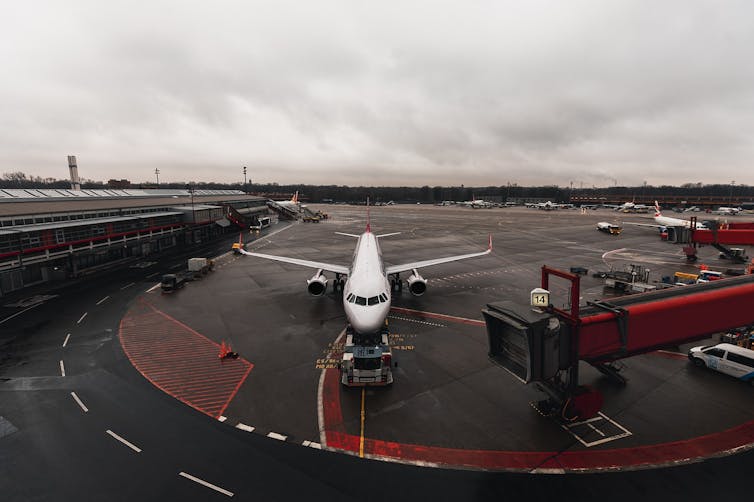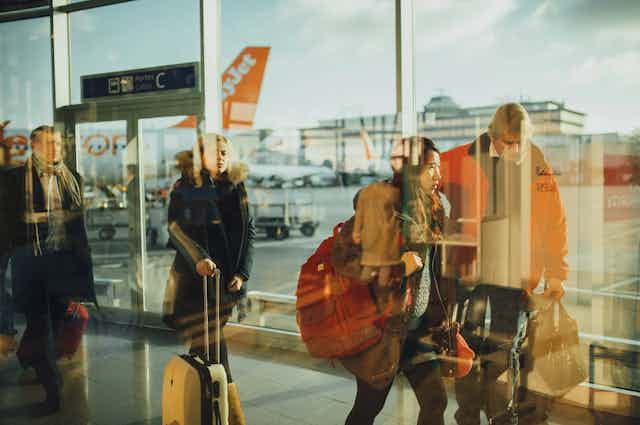Just before the pandemic, aircraft engines were burning one billion litres of fuel a day. But then the number of daily civil aviation flights fell from 110,000 to less than 50,000 during 2020, on average. With the easing of travel restrictions, air traffic is increasing back towards its pre-pandemic peak.
Most world leaders and delegates will have flown to Glasgow to attend COP26 – the 26th annual UN climate change summit – in person. But as they haggle over emissions targets to limit global warming to 1.5°C, and not 3°C or more, aviation is unlikely to be included in them, given the lack of low-carbon alternatives to long-haul flights.
But it should be. In new research, my colleagues and I calculated that if the aviation sector continues to grow on its present trajectory, its jet fuel consumption will have added 0.1˚C to global warming by 2050 – half of it to date, the other half in the next three decades.
Aviation is responsible for 4% of the 1.2°C rise in the global mean temperature we have already experienced since the industrial revolution. Without action to reduce flights, the sector will account for 17% of the remaining 0.3°C left in the 1.5°C temperature target, and 6% of the 0.8°C left to stay within 2°C. Airlines effectively add more to global warming than most countries.
Warming footprints
At the current rate, the world will have warmed by 2°C within three decades. To quantify how different activities contribute to warming, scientists measure carbon emissions. This is because how much the Earth warms is proportional to cumulative carbon emissions in the atmosphere. This is a very good approximation in many cases, but it is inaccurate for emissions caused by aeroplanes travelling at altitudes of up to 12 kilometres.
As well as CO₂, aircraft engines emit nitrogen oxides, water vapour, sulphur and soot, causing contrail cirrus clouds and other complicated chemical reactions in the atmosphere. The sum of these so-called non-CO₂ effects adds more warming on top of the CO₂ emissions. So the total warming footprint of aviation is between two and three times higher than a conventional carbon footprint.

While a large share of a flight’s CO₂ emissions remain in the atmosphere for many thousands of years, the non-CO₂ effects diminish over time, vanishing within about ten years. So any growth in aviation, measured in global jet fuel consumption, has an amplified impact as both CO₂ and non-CO₂ effects add up.
But a decline in aviation can partly reverse some warming, as the non-CO₂ effects disappear over time until only the CO₂ effects remain. Think of the non-CO₂ effects like a bathtub – it fills up when the taps are turned further and further, despite a slow outflow down the plughole. But the same bathtub will eventually empty if the taps are gradually turned down.
The non-CO₂ effects of flights on the atmosphere will slowly disappear if fewer and fewer flights are taken, so that aviation’s contribution to warming eventually levels off. In that situation, the increase from continued CO₂ emissions would balance the fall in non-CO₂ effects, and although aviation would still contribute to climate change, the total warming from both would remain constant over time. How much would aviation need to shrink to level off its influence on global warming?
Our calculations show that flying does not need to stop immediately to prevent aviation’s contribution to global warming expanding. Flying has already caused 0.04°C of warming to date. But with a yearly decrease of 2.5% in jet fuel consumption, currently only achievable with cuts in air traffic, this warming will level off at a constant level over the coming decades.
When do we really need to fly?
COVID-19 had a huge impact on the aviation sector. Air traffic is still approximately 10-20% below pre-pandemic levels, but is rebounding quickly. Politicians should shift subsidies from flying to more sustainable modes of transport, such as train journeys. And there is much more that can be done.

Lockdowns and the shift to remote working made many people rethink the necessity of flying. People resolving to fly less can contribute considerably to reducing the number of unnecessary flights. Combining in-person and virtual attendance in hybrid meetings wherever possible is a great way to support that shift.
Reducing the space that business classes take on aeroplanes is another way to cut the number of flights, as it allows more passengers to travel on one flight.
Not allowing airport expansions could also have a big impact. The UK’s Climate Change Committee, an expert body which advises the UK government, has recommended not expanding airports to align the sector with climate targets. Yet the expansion of Heathrow airport is currently planned to go ahead.
Sustainable aviation fuels, and hydrogen or electric planes, are being developed, but none of these technologies are currently available at the necessary scale. At the moment, there is little chance of the aviation industry meeting any climate targets if it aims for a return to its pre-pandemic rate of growth.

This story is part of The Conversation’s coverage on COP26, the Glasgow climate conference, by experts from around the world.
Amid a rising tide of climate news and stories, The Conversation is here to clear the air and make sure you get information you can trust. More.

